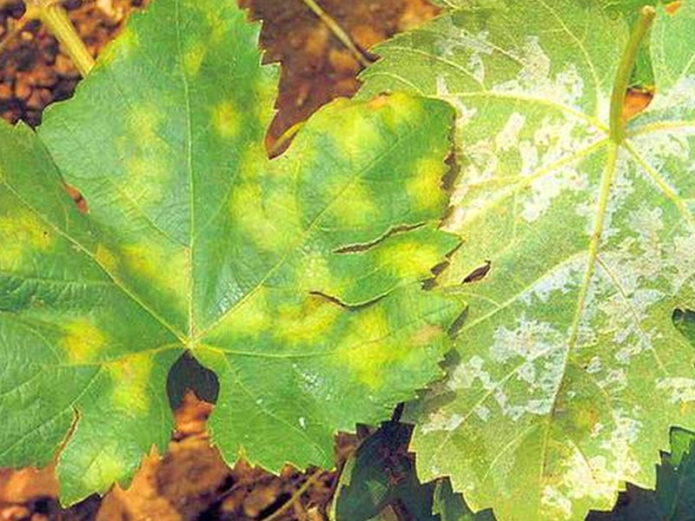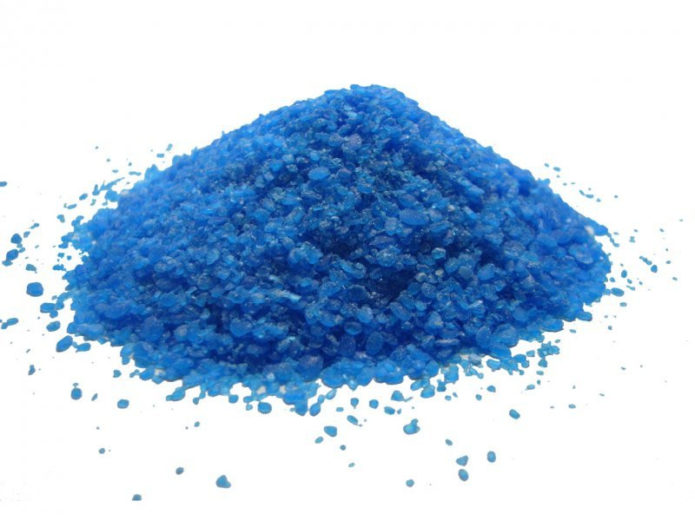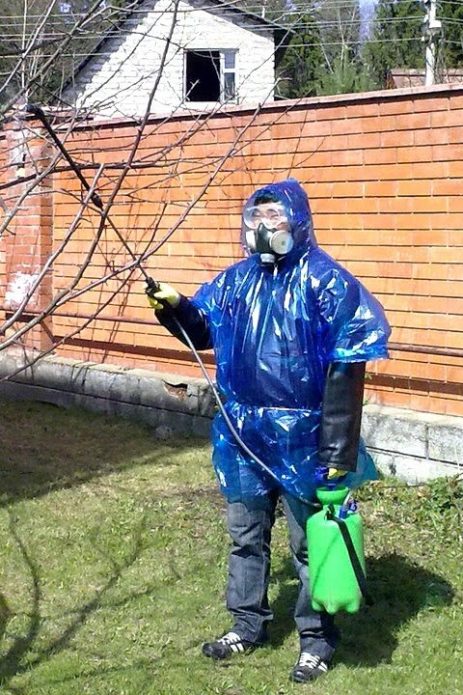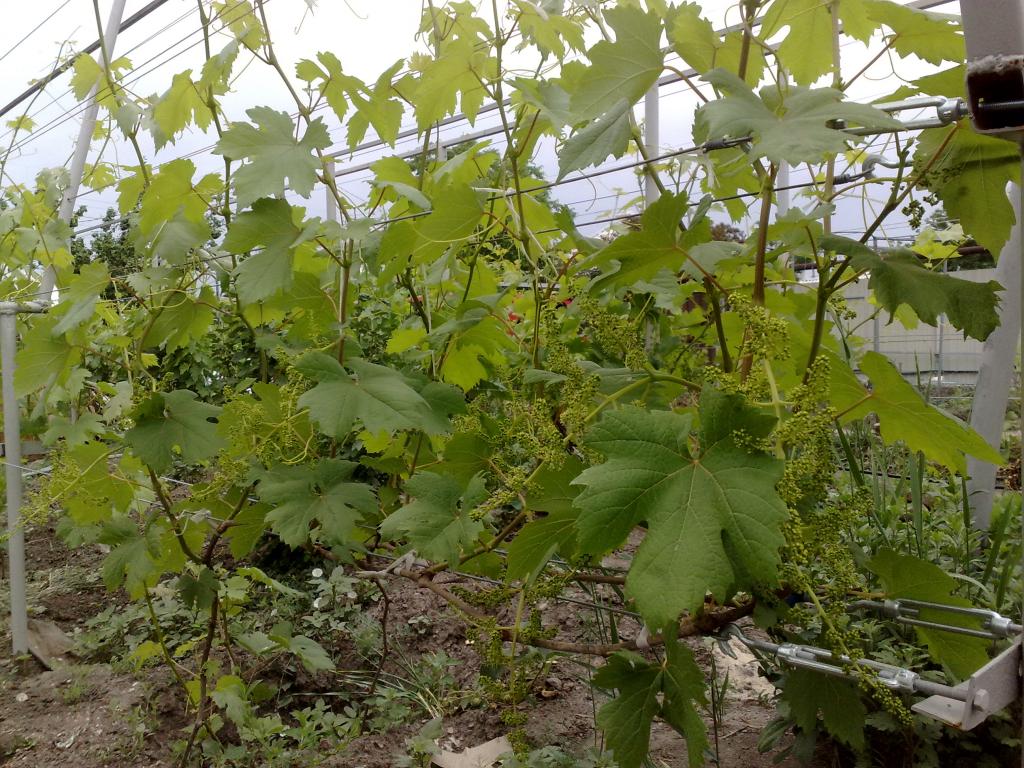Iron sulfate is one of the traditional chemicals used in horticulture and horticulture. Due to its versatile properties and low toxicity, it is widely used by winegrowers as a fungicide, fertilizer, and also for other important purposes. Despite the availability of many new drugs for the fight against diseases and pests on the market, iron vitriol does not lose its popularity.
Content
Characteristics of the drug
From the point of view of chemical structure, ferrous sulfate is a crystalline hydrate. Its correct full name is iron (II) sulfate heptahydrate. This means that in the crystalline state, 7 water molecules are firmly bound to one molecule of ferrous sulfate. When dissolved in water, they are easily split off, and in an aqueous solution, the drug is exactly the same salt as ordinary ferrous sulfate.
The anhydrous salt of iron (II) sulfate is a white crystalline substance, odorless, greedily absorbs moisture from the air. In this sense, ferrous sulfate is a much more stable drug. As FeSO47H2O, which looks like crystals of light green color, it is easily separated from aqueous solutions of iron sulfate.
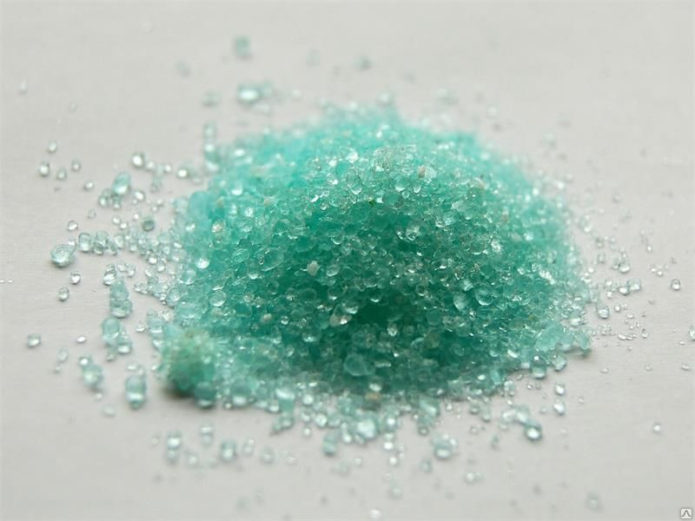
Freshly obtained crystals of ferrous sulfate are very beautiful, but they will remain so only if stored correctly.
During storage, ferrous sulfate partially erodes, giving off water and acquiring a yellowish tint due to surface oxidation, therefore, the composition of the crystalline hydrate is not completely constant. With strong heating (above 300 aboutC) turns into anhydrous salt.
It dissolves well in water, but in solution it is gradually oxidized by atmospheric oxygen to iron (III) sulfate, therefore, solutions, in fact, are a mixture of different salts. At room temperature, the solubility of the technical preparation is about 26.6 g per 100 ml of water. In aqueous solution, it slowly hydrolyzes, as a result of which the solution becomes cloudy due to the precipitation of iron hydroxosulfate. Hydrolysis is prevented by adding a small amount of sulfuric acid.
Some fans of modern drugs to combat plant diseases and pests call vitriol an "ancient" remedy. However, this substance is one of the most non-toxic drugs used in vineyards, and its spectrum of action is unique.
Iron vitriol is an effective drug in the fight against pests of gardens and vegetable gardens. It destroys mosses, lichens, and fungal spores well. As a microfertilizer containing iron in an easily accessible form, it is used for foliar feeding of plants by dissolving 5–10 g of the preparation in a bucket of water. Iron is one of the most important trace elements. It is necessary for the successful growth of the grape bush and the timely ripening of a full harvest.The need for feeding with iron can be signaled by blanching and shedding of leaves, slow growth of shoots, poor formation of berries.
Iron sulfate is used to treat grapes in order to combat such dangerous diseases as mildew, anthracnose, bacterial cancer, oidium, etc.
The drug destroys harmful insects and lichens, increases the elasticity of vines, improves the process of photosynthesis. It is a chemical of contact action, does not penetrate deep into plant tissues, its excess is easily washed off with water and does not enter the human body when consumed. It is used for other purposes as well. The main ones are the treatment of cracks in tree trunks, treatment of wounds, disinfection of surfaces in storage facilities.
Iron sulfate in vineyards is used not only as a fungicide and fertilizer. It has the unique property of delaying bud opening for about 1–2 weeks. Therefore, if you spray the bushes with a 3% solution before the buds begin to swell, this will help the grapes survive the threat of spring frosts. It is best to carry out this event about a week after opening the vines from winter storage.
Terms and conditions for processing with iron sulfate
The vineyard is treated with iron sulfate twice during the season: in spring and autumn. Spring spraying can be done within a few days after the winter shelter has been removed. If it was a consumable material (spruce branches of coniferous trees, dry foliage, brushwood), it is better to burn the shelter. Reusable materials (boards, slate, etc.) should also be neutralized at the same time by spraying with the same solution. In the fall, before the bushes are sheltered for the winter, preventive treatment is carried out. Both the vine and the soil around the bush are sprayed in both spring and autumn.
Spring spraying must be done before the buds swell, and even more so - the leaves appear: the solution of ferrous sulfate is low-toxic, but due to hydrolysis, it has an acidic reaction of the environment, and is able to burn green plant tissues.
The specificity of vitriol is that salt is hydrolyzed not only when it is in a large container with a solution, where this process is rather negative. Getting on the vine and spreading over it with a thin film, as a result of hydrolysis, ferrous sulfate covers the vine with a very thin film of basic salts. The film is quite strong and remains on the surface for some time, delaying the growing season for one to two weeks, allowing the bush to tolerate spring temperature fluctuations without loss. Subsequently, having completed its work on curbing vegetation and destroying pathogenic bacteria and fungi, the film of iron salts will be washed off by rains and dissolve in the soil layer, where it will play the role of micronutrient fertilization. It should be said right away that in the spring they use solutions of low concentration (from 50 g of the drug per bucket of water).
Re-processing of grapes with iron sulfate is carried out at the end of the season. This event protects the vineyard from the development of pathogens of a complex of diseases that thrive in decaying foliage and soil.
Autumn spraying can be performed after the entire mass of leaves has fallen, but it is more convenient to do this immediately before the grapes are sheltered for the winter, after all plant residues have been removed around the bushes.
Of course, it is important that during spraying, the air temperature is not high, but positive. As in the spring, you need to choose a dry and calm day for processing, and the weather forecast would not promise rain for the coming days.
It is very convenient to combine autumn processing with pruning and subsequent covering of the vine. After all, in the fall, you have to remove up to half of the wood: all areas of unripe vines, shoots clearly thickening the bush, sick, broken.So what's the point in wasting a solution to treat these areas if they will be immediately sent to the fire anyway? But in the fall, more concentrated solutions are used than in the spring. Even from an economic point of view, spraying before pruning is not entirely reasonable.
The autumn cultivation of the vineyard can also be carried out with copper sulfate, which generally performs similar functions. But copper sulfate is more toxic than iron sulfate. And if earlier this fact was not paid special attention and used in gardens copper preparations almost without restriction, in recent decades they have been trying to gradually oust them from the list of the most common chemicals, replacing them with modern developments that do not contain copper. Iron vitriol in this regard has no limitations: as you know, even the human body needs iron in considerable quantities.
In addition to processing adult bushes, ferrous sulfate is also used for processing cuttings before planting in the ground, both indoors and directly in the garden. The top of the cutting, that part of it that will be above the ground, is dipped in a weak solution of ferrous sulfate (not stronger than 1%) for several minutes. The role of the drug in this case is similar to that described above. It slows down the opening of the buds until the young roots appear on the lower buds placed in the ground, which will begin to feed the cutting. As a result of this technique, the cuttings take root and grow better.
Video: autumn spraying of vines with a solution of ferrous sulfate
Preparation and use of the drug, proportions, dosages
Iron sulfate dissolves easily in water, and there are no problems with preparing solutions. For the processing of grapes, considerable volumes of solutions are required, depending, of course, on the number and age of the bushes, but most often it is at least a few liters. Since the drug is practically non-toxic to warm-blooded animals and, in particular, to humans, the maximum degree of protection when preparing solutions is to use rubber gloves. A respirator is required only when using a solution: after all, getting an aerosol into the respiratory system is completely useless. And experienced gardeners prepare the solution without gloves.
After measuring the required volume of clean water at room temperature and weighing the required amount of the chemical, you just need to pour it into the water in a thin stream, stirring continuously. Then mix until completely dissolved and pour into a sprayer.
If you got a not very pure technical preparation, a small part of it may not dissolve. As a rule, possible impurities present in iron vitriol are completely harmless, but the sediment can clog the sprayer nozzle, so in this case, the solution must be filtered or simply allowed to settle for a while: the turbidity will settle very soon.
If you know what kind of trouble you have to fight, it is worth referring to the reference data indicating which concentration of the working solution should be created in this or that case. So, for example, for the fight against lichens, the optimal concentration is 3%, with chlorosis - 0.05%, and for the destruction of foci with mildew or oidium - up to 5%. In the case of the real presence of specific diseases, these recommendations must be strictly followed. But when the reason for the poor health of the vineyard is not established, as well as when using ferrous sulfate for preventive purposes, the calculation can be made easier. Considering that a lower concentration of the solution is desirable for spring treatment than for autumn, one should rely on universal values of concentrations.
In the spring, prepare a 0.5-1% solution, that is, weigh from 50 to 100 g of the drug into a bucket of water. In autumn, a concentration of 3 to 5% is created using weighed portions of 300-500 g.
When preparing a solution, it is extremely undesirable to add other substances to it: for example, lime will lead to the precipitation of iron hydroxide, and it is difficult to predict in advance how drugs to combat diseases of a particular class will behave.
Safety measures when working with iron sulfate
Iron vitriol belongs to 3 groups of hazard, which is characterized by the concept of "low-hazard substances". This means that when working with it, you must observe basic safety measures, that is, behave a little more collected than, for example, when preparing sugar syrup or pickling tomatoes. When spilling the solution on the skin, there is absolutely no need to panic, but simply rinse the doused areas of the body with water.
The situation is slightly worse when the solution gets into the eyes: after all, as a result of the hydrolysis of vitriol, these solutions are quite acidic, and when washing the eyes with a stream of water (which must be done immediately), it is advisable to use a weak solution of baking soda. If you do not have the skills to work with chemicals and there is a certain fear of getting into such a situation, it is better to wear glasses before preparing a solution of ferrous sulfate.
It is clear that no one will specifically drink the prepared solution. But if this happens by accident, you need to drink a lot of warm water (at least a liter and a half) and try to induce vomiting. Then 1-2 sips of solution will pass without a trace. If large amounts of the solution get inside after the described procedure, you should drink a glass of soda solution (a pinch of soda) and consult a doctor. To avoid accidents, of course, chemical preparations should be stored separately from food and only special dishes should be used for them.
Before the process of spraying the solution on the grape bushes, you must put on special clothing.
Of course, this is by no means a suit of chemical protection, but nevertheless it is not worth working naked. It is advisable to wear:
- any suit that completely covers the skin: one that, after processing, can be sent to a regular wash;
- rubber boots or other shoes that can be easily washed;
- a headdress with similar requirements;
- protective glasses; in their absence - at least ordinary glasses that reliably protect the eyes from splashing solution;
- the simplest anti-aerosol respirator (Alina, Lepestok, etc.), in the absence - a gauze bandage on the mouth and nose;
- rubber gloves: throw away disposable ones after use, wash tight ones.
If spot spraying is carried out with a household spray bottle, only gloves can be used.
Iron vitriol is a worthy representative of simple means of combating plant diseases and their pests. It is widely used by winegrowers due to its low toxicity and broad spectrum of activity. Spraying vines in autumn and spring destroys most of the pathogens and increases plant immunity.
